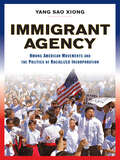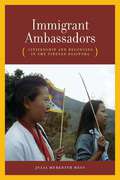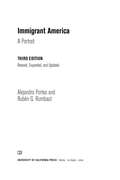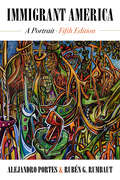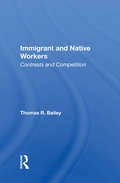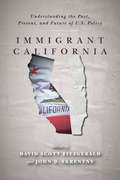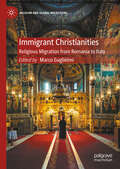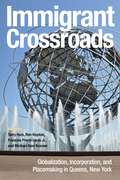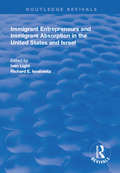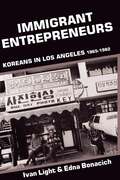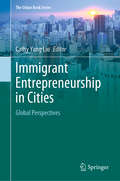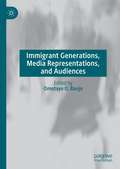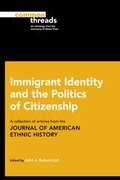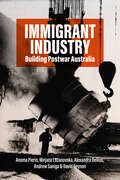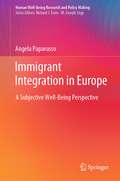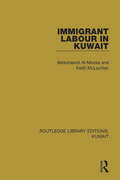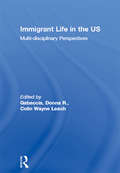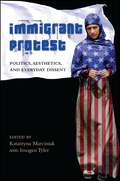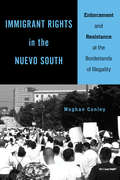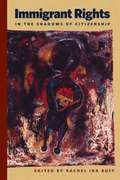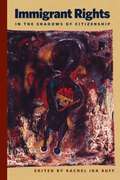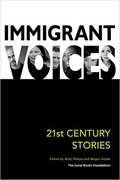- Table View
- List View
Immigrant Agency: Hmong American Movements and the Politics of Racialized Incorporation
by Yang Sao XiongThrough a sociological analysis of Hmong former refugees’ grassroots movements in the United States between the 1990s and 2000s, Immigrant Agency shows how Hmong, despite being one of America’s most economically impoverished ethnic groups, were able to make sustained claims on and have their interests represented in public policies. The author, Yang Sao Xiong argues that the key to understanding how immigrants incorporate themselves politically is to understand how they mobilize collective action and make choices in circumstances far from racially neutral. Immigrant groups, in response to political threats or opportunities or both, mobilize collective action and make strategic choices about how to position themselves vis-à-vis other minority groups, how to construct group identities, and how to deploy various tactics in order to engage with the U.S. political system and influence policy. In response to immigrants’ collective claims, the racial state engages in racialization which undermines immigrants’ political standing and perpetuates their marginalization.
Immigrant Ambassadors: Citizenship and Belonging in the Tibetan Diaspora
by Julia Meredith HessHess (anthropology, U. of New Mexico) examines articulations of Tibetanness among stateless Tibetans in India and among Tibetans resettled in the United States and in the process of becoming US citizens. She describes a transformation of diaspora consciousness among the Tibetans giving up their stateless status and adopting US citizenship through an examination of Tibetan responses to the bureaucratic processes required to procure identity documents, travel documents, visas, asylum applications, citizenship ceremonies, and passports. She finds that the Tibetans involved in the Tibetan US Resettlement Project invest citizenship with multiple meanings and that many are adopting US citizenship in an effort to become more effective transnational political actors in the cause of an independent Tibet. Annotation ©2009 Book News, Inc. , Portland, OR (booknews. com)
Immigrant America: A Portrait
by Alejandro Portes Rubén G. RumbautThis third edition of the widely acclaimed classic has been thoroughly expanded and updated to reflect current demographic, economic, and political realities. Drawing on recent census data and other primary sources, Portes and Rumbaut have infused the entire text with new information and added a vivid array of new vignettes and illustrations.Recognized for its superb portrayal of immigration and immigrant lives in the United States, this book probes the dynamics of immigrant politics, examining questions of identity and loyalty among newcomers, and explores the psychological consequences of varying modes of migration and acculturation. The authors look at patterns of settlement in urban America, discuss the problems of English-language acquisition and bilingual education, explain how immigrants incorporate themselves into the American economy, and examine the trajectories of their children from adolescence to early adulthood. With a vital new chapter on religion—and fresh analyses of topics ranging from patterns of incarceration to the mobility of the second generation and the unintended consequences of public policies—this updated edition is indispensable for framing and informing issues that promise to be even more hotly and urgently contested as the subject moves to the center of national debate..
Immigrant America: A Portrait
by Prof. Alejandro Portes Prof. Rubén G. RumbautThis revised and updated fifth edition of Immigrant America: A Portrait provides a comprehensive and current overview of immigration to the United States, including its history, the principal theories seeking to account for its diverse origins, the main types of immigrants, and the various forms of immigrants' incorporation within American society. With the latest available data, Immigrant America further explores the economic, political, regional, linguistic, and religious aspects of immigration. It offers detailed analyses of the adaptation process experienced by adult children of immigrants and adds an updated and expanded concluding chapter on changing immigration policy regimes both past and present.
Immigrant And Native Workers: Contrasts And Competition
by Thomas R BaileyOriginally published in 1987, this book presents a novel approach to the study of competition between immigrant groups and native minorities (teenagers, women, and black men) in low-wage labor markets.
Immigrant California: Understanding the Past, Present, and Future of U.S. Policy
by David Scott FitzGerald and John D. SkrentnyIf California were its own country, it would have the world's fifth largest immigrant population. The way these newcomers are integrated into the state will shape California's schools, workforce, businesses, public health, politics, and culture. In Immigrant California, leading experts in U.S. migration provide cutting-edge research on the incorporation of immigrants and their descendants in this bellwether state. California, unique for its diverse population, powerful economy, and progressive politics, provides important lessons for what to expect as demographic change comes to most states across the country. Contributors to this volume cover topics ranging from education systems to healthcare initiatives and unravel the sometimes-contradictory details of California's immigration history. By examining the past and present of immigration policy in California, the volume shows how a state that was once the national leader in anti-immigrant policies quickly became a standard-bearer of greater accommodation. California's successes, and its failures, provide an essential road map for the future prosperity of immigrants and natives alike.
Immigrant Christianities: Religious Migration from Romania to Italy (Religion and Global Migrations)
by Marco GuglielmiOver the past two decades, Romanian immigration to the Italian Peninsula has grown to nearly a quarter of the country&’s foreign population, making it the largest Romanian diaspora in the world. This volume is the first to examine the religious dimension of this vast migratory phenomenon from multiple perspectives, including sociology, anthropology, ethnology, history, and theology.The chapters study the patterns and transformations of Romanian Churches and Christian movements in Italy, with particular attention to the Romanian Orthodox Church, the Romanian Roman Catholic Church, the Romanian Greek-Catholic Church, and the Romanian Pentecostal Church. They also analyze how these immigrant Churches and religious movements engage with Italian society and respond to contemporary challenges.Drawing on the study of the Romanian diaspora and grounded in a multidisciplinary perspective, this volume develops the notion of immigrant Christianities. The latter provides a heuristic framework for highlighting the growing entanglements and transformative dynamics shaping the multiplicity of immigrant Churches and Christian movements in the contemporary world.
Immigrant Crossroads: Globalization, Incorporation, and Placemaking in Queens, New York
by Tarry Hum, Ron Hayduk, Francois Pierre-Louis, and Michael Alan KrasnerNearly half the 2.3 million residents of Queens, New York are foreign-born. Immigrants in Queens hail from more than 120 countries and speak more than 135 languages. As an epicenter of immigrant diversity, Queens is an urban gateway that exemplifies opportunities and challenges in shaping a multi-racial democracy. The editors and contributors to Immigrant Crossroads examine the social, spatial, economic, and political dynamics that stem from this fast-growing urbanization. The interdisciplinary chapters examine residential patterns and neighborhood identities, immigrant incorporation and mobilizations, and community building and activism. Essays combine qualitative and quantitative research methods to address globalization and the unprecedented racial and ethnic diversity as a result of international migration. Chapters on incorporation focus on immigrant participation and representation in electoral politics, and advocacy for immigrant inclusion in urban governance and service provision. A section of Immigrant Crossroads concerns placemaking, focusing on the production of neighborhood spaces and identities as well as immigrant activism and community development and control. Based on engaged and robust analysis, Immigrant Crossroads highlights the dynamics of this urban gateway.
Immigrant Crossroads: Globalization, Incorporation, and Placemaking in Queens, New York
by Tarry Hum, Ron Hayduk, Francois Pierre-Louis, and Michael Alan KrasnerNearly half the 2.3 million residents of Queens, New York are foreign-born. Immigrants in Queens hail from more than 120 countries and speak more than 135 languages. As an epicenter of immigrant diversity, Queens is an urban gateway that exemplifies opportunities and challenges in shaping a multi-racial democracy. The editors and contributors to Immigrant Crossroads examine the social, spatial, economic, and political dynamics that stem from this fast-growing urbanization. The interdisciplinary chapters examine residential patterns and neighborhood identities, immigrant incorporation and mobilizations, and community building and activism. Essays combine qualitative and quantitative research methods to address globalization and the unprecedented racial and ethnic diversity as a result of international migration. Chapters on incorporation focus on immigrant participation and representation in electoral politics, and advocacy for immigrant inclusion in urban governance and service provision. A section of Immigrant Crossroads concerns placemaking, focusing on the production of neighborhood spaces and identities as well as immigrant activism and community development and control. Based on engaged and robust analysis, Immigrant Crossroads highlights the dynamics of this urban gateway.
Immigrant Entrepreneurs and Immigrants in the United States and Israel (Routledge Revivals)
by Ivan Light Richard E. IsralowitzFirst published in 1997, This book now opens the unduly delayed discussion about how Israel and the USA deal with immigration and how they are transformed by it. Approaching the discussion from the point of view of contemporary immigration research, this book prioritizes the economic processes of immigrant insertion in Israel and the USA, immigrant absorption and assimilation in both countries, policy debates, and women immigrants for extended treatment. Additionally, a photographic section mobilizes the new subject of visual sociology to continue the comparative analysis.
Immigrant Entrepreneurs: Koreans in Los Angeles, 1965-1982
by Ivan Light Edna BonacichA decade in preparation, Immigrant Entrepreneurs offers the most comprehensive case study ever completed of the causes and consequences of immigrant business ownership. Koreans are the most entrepreneurial of America's new immigrants. By the mid-1970s Americans had already become aware that Korean immigrants were opening, buying, and operating numerous business enterprises in major cities. When Koreans flourished in small business, Americans wanted to know how immigrants could find lucrative business opportunities where native-born Americans could not. Somewhat later, when Korean-black conflicts surfaced in a number of cities, Americans also began to fear the implications for intergroup relations of immigrant entrepreneurs who start in the middle rather than at the bottom of the social and economic hierarchy.Nowhere was immigrant enterprise more obvious or impressive than in Los Angeles, the world's largest Korean settlement outside of Korea and America's premier city of small business. Analyzing both the short-run and the long-run causes of Korean entrepreneurship, the authors explain why the Koreans could find, acquire, and operate small business firms more easily than could native-born residents. They also provide a context for distinguishing clashes of culture and clashes of interest which cause black-Korean tensions in cities, and for framing effective policies to minimize the tensions.
Immigrant Entrepreneurship in Cities: Global Perspectives (The Urban Book Series)
by Cathy Yang LiuThis book draws on evidence from global cities around the world and explores various dimensions of immigrant entrepreneurship and urban development. It provides a substantive contribution to the existing literature in several ways. First of all, it pursues a comparative approach, with case studies from both the global north and global south, so as to broaden the theoretical framework in this area especially as pertinent to emerging economies. Second, it covers multiple scales, from local community place-making, to urban contexts of reception, to transnational networks and connections. Third, it combines approaches and research methods from numerous disciplines, investigating entry dynamics, trends and patterns, business performance, challenges, and the impact of immigrant entrepreneurship in urban areas. Finally, it pays particular attention to current international experiences regarding urban policies on immigrant entrepreneurship. Given its scope, the book will be an enlightening read for anyone interested in immigration, entrepreneurship and urban development issues around the globe.As global cities around the world continue to attract both domestic migrants and international migrants to their bustling metropolises, immigrant entrepreneurship is emerging as an important urban phenomenon that calls for careful examination. From Chinatown in New York, to Silicon Valley in San Francisco, to Little Africa in Guangzhou, immigrant-owned businesses are not only changing the business landscape in their host communities, but also transforming the spatial, economic, social, and cultural dynamics of cities and regions.
Immigrant Exclusion and Insecurity in Africa
by Claire L. AdidaThis book explores the diverse immigrant experiences in urban West Africa, where some groups integrate seamlessly while others face exclusion and violence. It shows, counterintuitively, that cultural similarities between immigrants and their hosts do not help immigrant integration and may, in fact, disrupt it. This book is one of the first to describe and explain in a systematic way immigrant integration in the developing world, where half of all international migrants go. It relies on intensive fieldwork tracking two immigrant groups in three host cities, and draws from in-depth interviews and survey data to paint a picture of the immigrant experience from both immigrant and host perspectives.
Immigrant Generations, Media Representations, and Audiences
by Omotayo O. BanjoThis anthology examines how immigrants and their US-born children use media to negotiate their American identity and how audiences engage with mediated narratives about the immigrant experience (cultural adjustments, language use, and the like). Where this work diverges from other collections and monographs is the area is its intentional focus on how both first- and second-generation Americans’ complex identities and hybrid cultures interact with mediated narratives in general, alongside the extent to which these narratives reflect their experience. In a three-part structure, the collection examines representations, “zooms in” to explore the reception of these narratives through autoethnographic essays, and concludes in a section of analysis and critique of specific media.
Immigrant Identity and the Politics of Citizenship: A Collection of Articles from the Journal of American Ethnic History
by John J BukowczykThe next volume in the Common Threads book series, Immigrant Identity and the Politics of Citizenship assembles fourteen articles from the Journal of American Ethnic History. The chapters discuss the divisions and hierarchies confronted by immigrants to the United States, and how these immigrants shape, and are shaped by, the social and cultural worlds they enter. Drawing on scholarship of ethnic groups from around the globe, the articles illuminate the often fraught journey many migrants undertake from mistrusted Other to sometimes welcomed citizen. Contributors: James R. Barrett, Douglas C. Baynton, Vibha Bhalla, Julio Capó, Jr., Robert Fleegler, Gunlög Fur, Hidetaka Hirota, Karen Leonard, Willow Lung-Amam, Raymond A. Mohl, Mark Overmyer-Velázquez, Lara Putnam, David Reimers, David Roediger, and Allison Varzally.
Immigrant Industry: Building Postwar Australia
by Anoma Pieris, Mirjana Lozanovska, Alexandra Dellios, Andrew Saniga and David BeynonAfter the end of the Second World War, migrants were critical to the spatial making of modern Australia. Major federally funded industries driving postwar nation-building programs depended on the employment of large numbers of people who had been displaced by the war. Directed to remote, rural and urban industrial sites, migrant labor and resettlement altered the nation’s physical landscape, providing Australia with its contemporary economic base. While the immigrant contribution to nation-building in cultural terms is well-known, its everyday spatial, architectural and landscape transformations remain unexamined. This book aims to bring to the foreground postwar industry and immigration to comprehensively document a uniquely Australian shaping of the built environment.
Immigrant Integration in Europe: A Subjective Well-Being Perspective (Human Well-Being Research and Policy Making)
by Angela PaparussoThis topical book sheds light on immigrants’ subjective well-being by analysing the main factors associated with self-reported life satisfaction among immigrants and natives. It thereby draws upon subjective components of well-being, which are now receiving growing attention in well-being research. It also fills in a gap in migration research, which has not yet focused on the study of immigrants’ well-being. Starting from a broader focus on Europe, the book then looks more closely at Italy. This is a key country in the immigration policy field in Europe, but where the study of immigrants’ integration from a subjective perspective has been rarely addressed so far. The book provides suggestions for constructing and implementing immigration and integration policies by not only taking into account the needs of the host societies, but also the experiences, opinions, requirements and expectations of immigrants. This book is very useful for academic and policy researchers working on immigrant integration issues.
Immigrant Labour in Kuwait (Routledge Library Editions: Kuwait #2)
by Keith Mclachlan Abdulrasool Al-MoosaKuwait has among the highest levels of personal incomes in the Middle East and the best oil reserves to production ratios of all the exporting states. Its good material fortune is offset by its political precariousness engendered by Kuwaiti nationals forming a minority and a heavy dependency on immigrants to sustain the economy. Deep feelings of insecurity have led to calls in Kuwait for an end to immigration and the repatriation of foreign residents of the state. This book, first published in 1985, analyses the degree of dependency of Kuwait on an alien working population from the results of a unique survey undertaken among the crucial family-accompanied segment of the immigrant workforce. The authors suggest new approaches to the evaluation of the utility of the foreigners to the local economy that might help to stave off a mounting internal crisis.
Immigrant Life in the US: Multi-disciplinary Perspectives (Routledge Advances in Sociology)
by Donna R. Gabaccia Colin Wayne LeachImmigrant Life in the U.S. brings together scholars from across the disciplines to examine diverse examples of immigration to the paradigmatic 'nation of immigrants'. The volume covers a wide range of time periods, ethnic and national groups, and places of immigration. Contemporary Chinese children brought to the U.S. through adoption, Mexican laborers hired to work in the mid-west in the 1930s, Indian computer programmers hired to work in California, and more, are examined in a series of chapters that show the great diversity of issues facing immigrants in the past and in the present. This book emphasizes the complex tapestry that is the everyday experience of life as an immigrant and turns a critical eye on the place of globalization in the everyday life of immigrants. The contrasts it draws between past and present demonstrate the continued salience of national and ethnic identities while also describing how migrants can live almost simultaneously in two countries. This book will be of essential interest to advanced students and researchers of Sociology, History, Ethnic Studies and American Studies.
Immigrant Protest: Politics, Aesthetics, and Everyday Dissent (SUNY series, Praxis: Theory in Action)
by Katarzyna Marciniak; Imogen TylerThe last decade has witnessed a global explosion of immigrant protests, political mobilizations by irregular migrants and pro-migrant activists. This volume considers the implications of these struggles for critical understandings of citizenship and borders. Scholars, visual and performance artists, and activists explore the ways in which political activism, art, and popular culture can work to challenge the multiple forms of discrimination and injustice faced by "illegal" and displaced peoples. They focus on a wide range of topics, including desire and neo-colonial violence in film, visibility and representation, pedagogical function of protest, and the role of the arts and artists in the explosion of political protests that challenge the precarious nature of migrant life in the Global North. They also examine shifting practices of boundary making and boundary taking, changing meanings and lived experiences of citizenship, arguing for a noborder politics enacted through a "noborder scholarship."This book is freely available in an open access edition thanks to Knowledge Unlatched—an initiative that provides libraries and institutions with a centralized platform to support OA collections and from leading publishing houses and OA initiatives. Learn more at the Knowledge Unlatched website at: https://www.knowledgeunlatched.org/, and access the book online at the SUNY Open Access Repository at http://hdl.handle.net/20.500.12648/7127.
Immigrant Rights in the Nuevo South: Enforcement and Resistance at the Borderlands of Illegality
by Meghan ConleyEvery day, undocumented immigrants are rendered vulnerable through policies and practices that illegalize them. Moreover, they are socially constructed into dangerous criminals and taxpayer burdens who are undeserving of rights, dignity, and respect. Meghan Conley’s timely book, Immigrant Rights in the Nuevo South, seeks to expose and challenge these dehumanizing ideas and practices byexamining the connections between repression and resistance for unauthorized immigrants in communities across the American Southeast. Conley uses on-the-ground interviews to describe fear and resistance from the perspective of those most affected by it. She shows how, for example, the Illegal Immigration Reform and Enforcement Act in Georgia prompted marches and an action that became “a day of non-compliance.” Likewise, an “enforcement lottery” that created unpredictable threats of arrest and deportation in the region mobilized immigrants to organize and demonstrate. However, as immigrant rights activists mobilize in opposition to the criminalization of undocumented people, they may unintentionally embrace stories of who deserves to be in the United States and who does not. Immigrant Rights in the Nuevo South explores these paradoxes while offering keen observations about the nature and power of Latinx resistance.
Immigrant Rights in the Shadows of Citizenship
by Rachel BuffPunctuated by marches across the United States in the spring of 2006, immigrant rights has reemerged as a significant and highly visible political issue. Immigrant Rights in the Shadows of U. S. Citizenship brings prominent activists and scholars together to examine the emergence and significance of the contemporary immigrant rights movement. Contributors place the contemporary immigrant rights movement in historical and comparative contexts by looking at the ways immigrants and their allies have staked claims to rights in the past, and by examining movements based in different communities around the United States. Scholars explain the evolution of immigration policy, and analyze current conflicts around issues of immigrant rights; activists engaged in the current movement document the ways in which coalitions have been built among immigrants from different nations, and between immigrant and native born peoples. The essays examine the ways in which questions of immigrant rights engage broader issues of identity, including gender, race, and sexuality.
Immigrant Rights in the Shadows of Citizenship (Nation of Nations #15)
by Rachel Ida BuffPunctuated by marches across the United States in the spring of 2006, immigrant rights has reemerged as a significant and highly visible political issue. Immigrant Rights in the Shadows of U.S. Citizenship brings prominent activists and scholars together to examine the emergence and significance of the contemporary immigrant rights movement. Contributors place the contemporary immigrant rights movement in historical and comparative contexts by looking at the ways immigrants and their allies have staked claims to rights in the past, and by examining movements based in different communities around the United States. Scholars explain the evolution of immigration policy, and analyze current conflicts around issues of immigrant rights; activists engaged in the current movement document the ways in which coalitions have been built among immigrants from different nations, and between immigrant and native born peoples. The essays examine the ways in which questions of immigrant rights engage broader issues of identity, including gender, race, and sexuality.
Immigrant Voices: 21st Century Stories
by Great StaffThe eighteen stories collected in Immigrant Voices highlight the complex relationships of immigrants in the United States at the beginning of the twenty-first century with their families, friends, new surroundings, and home countries. The authors themselves have made many of the same kinds of transitions as the characters they portray, and they offer fresh perspectives on the immigrant experience. Coedited by award-winning author Achy Obejas and cultural studies scholar Megan Bayles, this anthology addresses the perennial questions about society and the individual that the authors of the Great Books have pondered for centuries.
Immigrant Voices: New Lives in America, 1773-2000
by Thomas DublinA classroom staple, Immigrant Voices: New Lives in America, 1773-2000 has been updated with writings that reflect trends in immigration to the United States through the turn of the twenty-first century. New chapters include a selection of letters from Irish immigrants fleeing the famine of the 1840s, writings from an immigrant who escaped the civil war in Liberia during the 1980s, and letters that crossed the U.S.-Mexico border during the late 1980s and early '90s. With each addition editor Thomas Dublin has kept to his original goals, which was to show the commonalities of the U.S. immigrant experience across lines of gender, nation of origin, race, and even time.
